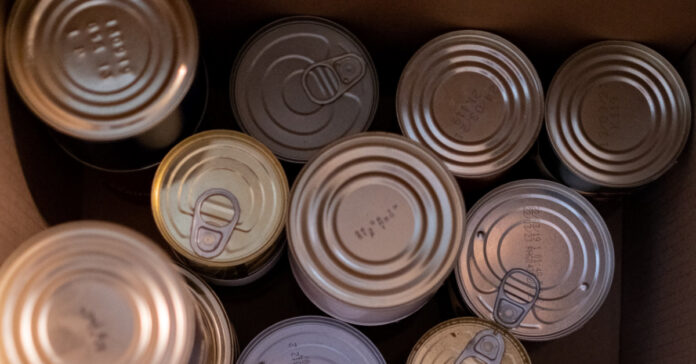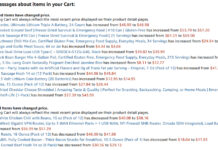A week ago, I talked about why I am going to re-focus on building up my long term food storage. For those of you who are new to prepping or to this blog, let’s talk about how to build your food storage.
Food Storage in Layers
I believe in prepping in layers. This means you start with something basic and you build from there. For food storage, it breaks down like this:
Layer 1- Your Prepper Pantry
Build your prepper pantry using every-day items you buy at the grocery store or club store, like Sam’s Club or Costco. You can do this by buying five or ten things every week, or you can do it with a few dedicated shopping trips. Choose your approach based on your budget or your time frame.
Be sure to pick items that can last at least two years without refrigeration or freezing. If you get a can with a best buy date in 18 months, that’s OK; it will likely be edible for years after the date. Something like crackers or breakfast cereal may go stale. If I were starving, stale cereal would be fine, but your best bet is to buy what you or your family eat and then eating it before it expires and then replacing it in your pantry with a new purchase.
Pre-programmed Purchasing
If you want a simple approach, use the Amazon subscription service and order cases of foods you want in your pantry to be automatically delivered every three months. Then the next month order different items. In the third month, pick more items. You will end up getting cases or large bags of food delivered every month until you tell them to stop. Here’s a quick example:
Month One
- Libby’s corned beef hash
- Spam
- Hormel chili with beans
Month Two
- 5-pound box of oatmeal
- 10-pound bag of rice
- 5 pounds of dried beans
Month Three
- Cans of mixed vegetables
- At least six pounds of pasta
- Six jars of pasta sauce
You don’t have to stick with these foods. Substitute your own or add more. Things like tuna, roast beef, basked beans, dried beans, powdered milk, etc. Whatever you think you need to feed your family when times are tough. Some examples are found on our 30-day meal supply free PDF download.
Depending on your budget and the quantity you order for each delivery, you can build up your prepper pantry pretty quickly without having to expend much effort.
Once you have enough pantry food to live at least three months, you can start the next layer.
Layer Two – Long Term Storage
This is dried or dehydrated food that lasts 10 to 25 years. It normally comes in #10 cans or 5-gallon pails of 6-gallon buckets. It is usually packaged with oxygen absorbers to prolong the shelf life and the buckets are lined with Mylar bags to prevent oxygen that penetrates the plastic bucket from reaching the food.
I recommend you buy single item foods, things that can be used as ingredients or eaten by themselves. When starting out, avoid a meal in a can. For example, I recently purchased three #10 cans of chopped onions and three #10 cans of dehydrated potato shreds. I also recommend potato dices, slices and granules; ABS Soup Mix, soup and stew bases, dried beans, banana chips or apple rings, pastas, dairy, and powdered eggs. Grains can be purchased in #10 cans, but will be cheaper in buckets. Instead of buying flour, buy hard red wheat and a grain mill to make your own.
Speaking of making your own, you can buy Mylar bags, oxygen absorbers and 5-gallon buckets and store your own food. Rice and beans purchased in large bags are perfect for this.
Avoid freeze-dried foods in this layer because they are much more expensive on a per-serving or per-calorie basis. Also, avoid buckets that promise you “30 servings” or “135 servings” of six items in pouches. In almost every case, these are over-priced products that do not provide enough calories for you to survive. A serving is not a meal. With these expensive food packages, you’ll end up eating 9 servings per day and the 30-serving bucket will last three days when you planned for it to last ten.
In my personal food storage plan, this layer is where I am concentrating because my prepper pantry is full.
Layer Three – Splurge a Little
Once you have a two-year supply of long-term storage food, you can spurge a little and buy expensive foods. These include the afore-mentioned freeze-dried foods. I recommend buying freeze dried meats instead of meals that include meat. For example, I have #10 cans of freeze-dried beef, pork and chicken in my stores. I don’t have chili mac or beef stroganoff.
Note that layer two is carb heavy. Use canned meats in Layer One and freeze-dried meats in Layer Three to provide some protein and fat from meats.
Freeze-dried cheese is very expensive, but unless you buy powdered cheese similar to what you find in the macaroni and cheese packets, you will have to buy it freeze-dried or make your own.
If you like the convenience of MREs, they also belong in Layer Three because of their high cost. (Just remember, MREs go bad. I’m eating most of mine because they are near the end of their life.) If you want deserts, candy, cookie mixes, etc. they belong in this group as well. The key is that you don’t splurge until you have a significant amount of food storage in your home or at your retreat. I don’t have any freeze dried ice cream, but if you’re splurging, why not?
When you are spending thousands of dollars, saving five percent can add up. Shop smart. Look at the pounds per can when evaluating different brands or size. Calculate the cost per pound or the cost per 100 calories before making your buying decision.
How Much Food is Enough?
I think that food is like money—you can never have enough “int he bank.” Some projections for nuclear winter say it could take ten years for crops to be viable again. Yikes!
How much you store is up to you, your budget, and your available storage space. If you want to know how much food is required to feed one person for a year, read, Do you know how much food it takes to last a year?







